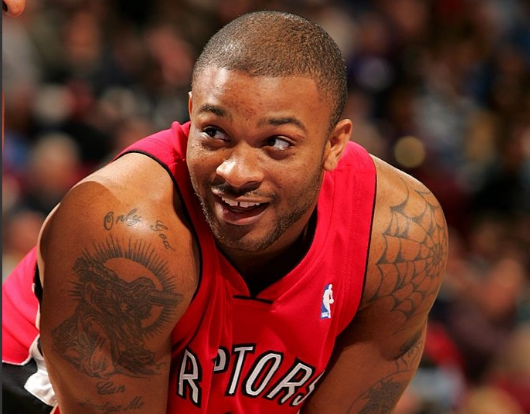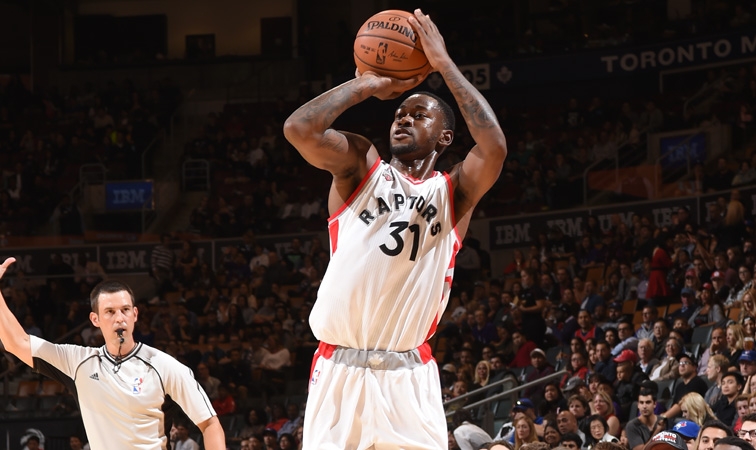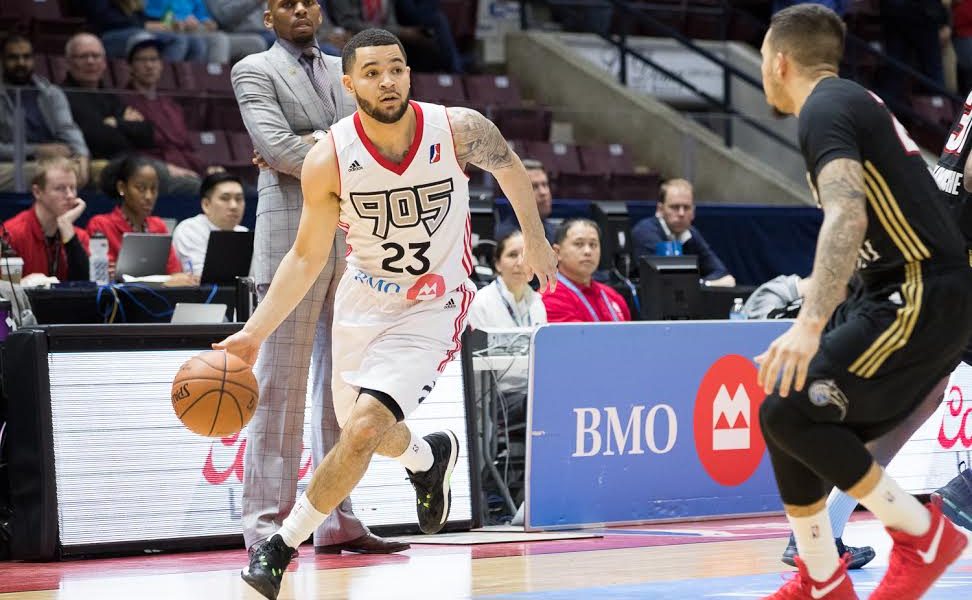Serge Ibaka was the big fish, but as long as Masai Ujiri has a phone, he’s not done working. He kept at it at Thursday’s trade deadline, sneaking a deal in just before the buzzer.
The Toronto Raptors are acquiring P.J. Tucker from the Phoenix Suns for Jared Sullinger and two second-round picks, according to a report from Adrian Wojnarowski of The Vertical.
The Raptors have been sniffing around Tucker for a year now, and the trigger was finally pulled on the former Raptors’ second-round pick. The news came in right at the deadline Thursday, perhaps meaning that Masai Ujiri, Jeff Weltman and company were weighing multiple deals or waiting for the asking price to come down. Phoenix was said to be adamant that they wanted a first-round pick for Tucker despite his status as an impending unrestricted free agent, and the Raptors did well here to acquire him surrendering only Sullinger’s similarly expiring contract and two second-rounders. The Raptors are giving up a 2017 and 2018 second-round pick, by the way, not some far-off future ones.
Acquiring Ibaka and Tucker while still keeping a first-round pick in a loaded 2017 draft and losing just a single rotation player outbound makes for a really nice nine days for the Raptors’ front office. The Raptors also acquire the Bird rights to each player ahead of their free agency, meaning they’ll be able to exceed the salary cap to retain either one. That doesn’t mean they will, necessarily – there’s a big luxury tax crunch coming for them this offseason – but the flexibility is nice to have. And again, they’ve maintained the bulk of their pick and prospect cache, keeping them in good shape at the back end of the roster, flush with inexpensive talent and the ability to make further moves if necessary.
The Cavaliers and Celtics, meanwhile, stood pat, while the Hawks added Ersan Ilyasova to their bench and the Wizards added Bojan Bogdanovic to theirs. A Celtics writer texted “sheesh Masai finessed,” and a Suns writer messaged “Love him” regarding Tucker, if you’re wondering how the outside world is responding to the deal. The Raptors improved more than any other team in the East over the past two weeks, and perhaps more than any team anywhere other than the New Orleans Pelicans. Facing some tough decisions about their place on the development curve and whether to push chips to the middle of the table or hold off for another window down the line, the Raptors managed to do both, making a pair of aggressive moves that still keep them in good shape down the line.
Tucker isn’t a seamless fit, of course, because the aisle the Raptors were shopping in didn’t include those. He’s a slightly below-average 3-point shooter at 33.8 percent on the year and 34.7 percent for his career, but he’s hit over 36 percent of his corner threes this season and is used to finding his touches in a low-usage role. The Raptors will ask little of him on offense beyond hard work, occasional offensive rebounds, and knocking down clean looks from the corners, and it’s a role Tucker’s well-suited to play, especially in lineups that have a little more spacing. He’d be a tight fit with DeRozan and a non-shooting big on the floor, for example, but the addition of Ibaka or Patrick Patterson allows the Raptors the option to invert the offense and maintain spacing while Tucker goes to work as a bully inside, similar to how the team used to deploy James Johnson.
And Johnson might be the best comparison point for Tucker, as he’ll be filling the Johnson role of the last two years in spirit and definition. A tough, game defender across three positions, the 6-foot-6, 245-pound Tucker will be leaned on to bring not only perimeter defense but an element of toughness some have felt the Raptors were lacking before the Ibaka acquisition. Tucker is a hard-nosed player, a high-effort addition, and someone who drew rave reviews for his impact on the Suns’ young locker room in recent years. In watching some footage today, he uses his strength extremely well, making it nearly impossible for opposing players to get to their spots – or the ball – when he’s denying position. He’s going to bring a lot of the attitude and physicality that Dwane Casey craves, and that kind of intensity can be contagious. In the words of Bismack Biyombo from early a year ago, the Raptors are unlikely to be punked at any point in the future.
The Raptors selected Tucker 25th overall in the 2006 draft, then saw him head to Europe to hone his game after one season. He returned to the NBA with Phoenix for the 2012-13 season, quickly emerging as a useful role player and quality defender. Other than an unsightly “extreme DUI” on his record from a few years back that saw him suspended for three games, things have gone smoothly in the desert. Tucker’s five NBA seasons have seen him earn a reputation as one of the more difficult defenders against larger wings – ask DeRozan – and he’ll provide an additional option against players like LeBron James and Paul George in the postseason. Phoenix hasn’t been particularly good defensively, but they’ve been better with Tucker on the floor, and most defensive metrics grade him as having a positive impact on that end of the floor.
The additions of Ibaka and Tucker not only improve the Raptors because these are good players, but because they mean the team’s rookies can now return to roles more befitting of rookies on contending teams. Pascal Siakam and Jakob Poeltl are likely gone from the rotation, Delon Wright, while impressive, won’t be tasked with sliding over to the wing in emergencies, and the Raptors have insurance if Norman Powell struggles in his new role or if DeMarre Carroll were to get injured. Ibaka and Tucker are big upgrades at the respective rotation spots they’re filling, even if the latter only figures to be the third or fourth wing and a matchup specialist.
The rotation figures to look something like this from here:
PG: Lowry, Joseph, Wright
SG: DeRozan, Powell
SF: Carroll, Tucker
PF: Ibaka, Patterson
C: Valanciunas, Nogueira, Poeltl
D-League: VanVleet, Caboclo, Siakam
That set up looks like a very solid 12-man rotation – it will only go nine on most nights, I’d expect – and it allows the team’s younger players, particularly Siakam, to return to a more deliberate development plan. That they were required so often early in the year will prove a positive down the line, but this is in their best interests.
As for Sullinger, well, he never really had a chance in Toronto. Injured in the opening game of the preseason, Sullinger spent months on a scooter and in a walking boot, unable to perform much cardio or keep in NBA shape. To his credit, once cleared he made efforts to pick up the schemes quickly and, once frustrated with his play, requested assignments to the D-League to improve his game conditioning. The Ibaka acquisition put the writing on the wall for Sullinger, and he’ll now get the chance to either play and rehab his value in Phoenix, or get bought out and catch on somewhere else. It’s a deal that didn’t pay off for Toronto, but he wound up contributing by standing as the salary matching piece that got them Tucker, a long-coveted addition.
So, again, that’s Ibaka and Tucker for Ross, Sullinger, a 2017 first, a 2017 second, and a 2018 second, keeping one 2017 first, losing just one rotation player, and keeping every one of the team’s prospects. They’re better today than they were 10 days ago, they’re still in good shape for the future, and while they’re still not a major threat to Cleveland, they once again appear to be the second-best team in the East.
Today is another good day.



